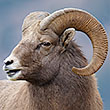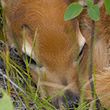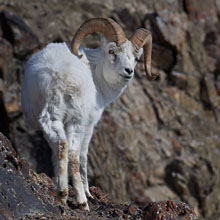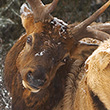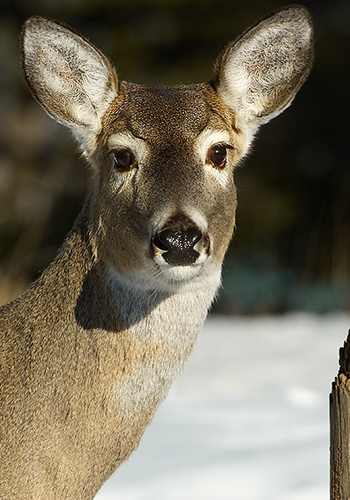
Availability: Undetermined - Enquiries?
In the Field
Portrait of a Doe. Findlay Creek, BC, Canada. February 2, 2006.
I've included this White-tailed doe image for one reason only. It was shot with strong direct sunlight with the sun almost directly overhead (i.e., was toplit). I've read countless times that you should avoid almost all outdoor photography at this time as the images turn out too contrasty and lacking in colour.
Well...with digital I can safely say that it's less of a problem than with colour transparencies, especially if you shoot RAW format images. And, you can mitigate the negative effects even more if you're working with a subject that will tolerate flash-fills. In this case I used no flash, and I did have to work pretty extensively with the digital file, primarily in an effort to lighten the shadow cast by the doe's snout. While I can't prove this, I'm pretty sure that the final image, especially the density of the shadow, closely resembles what my eyes recorded in the field.
Behind the Camera
Portrait of a Doe. Findlay Creek, BC, Canada. February 2, 2006.
Digital Capture; Compressed RAW (NEF) format; ISO 200.
Nikon D2X with Nikon 200-400 mm f/4G ED-IF AF-S VR lens @ 400 mm (600 mm equivalent with digital conversion factor) supported on Gitzo 1348 carbon fibre tripod with Wimberley head. VR turned to "On" and in "Normal" mode.
1/320s @ f7.1; -0.33 stop compensation from matrix-metered exposure setting.
At the Computer
Portrait of a Doe. Findlay Creek, BC, Canada. February 2, 2006.
RAW Conversion to 16-bit TIFF, including first-pass sharpening, exposure compensation, and tone curve adjustment, using Phase One's C1 Pro. Multiple RAW conversions (2 at different exposure settings) to extend dynamic range of captured image, in this case primarily to restore shadow detail in the neck region of the doe.
All further digital correction on 16-bit TIFF file using Adobe's Photoshop CS2, including tone curve adjustment, selective saturation enhancement and selective sharpening for web output.
Conservation
Portrait of a Doe. Findlay Creek, BC, Canada. February 2, 2006.
Species Status in Canada*: This species is not designated as at risk.
White-tailed Deer (Odocoileus virginianus) are one of the most widely distributed mammals in North America - they can be found in virtually all of southern Canada and in most of the American states. While whitetails are common now, in the late 1800's they were in serious risk of extinction - their populations had been reduced from about 40 million (across North America) to under 500,000. The conservation effort to return whitetails to numbers sufficient for long-term survival was massive and included strict harvest regulations, intense management, reintroductions, and habitat protection. Today, most populations in the United States do not represent original stock and the distinction of most historical subspecies is uncertain.
Whitetails resemble Mule Deer quite closely, and the two species overlap in distribution in western North America. The two species tend to prefer different habitats, with whitetails occupying more heavily forested land and along river valley bottoms, while muleys tend to prefer uplands and montane areas. On rare occasions, the two species will interbreed. Occasionally the offspring are fertile, but in most cases they are sterile.
*as determined by COSEWIC: The Committee on the Status of Endangered Wildlife in Canada


















